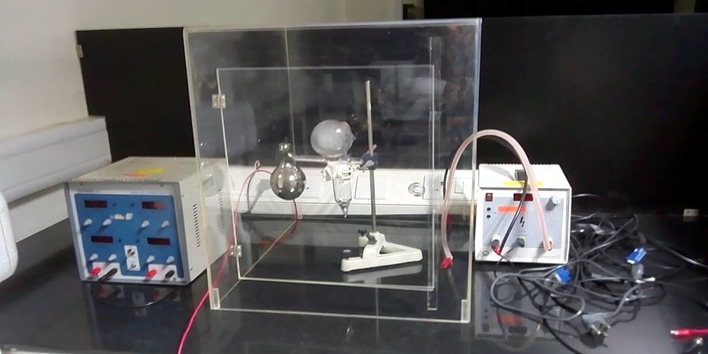Many experiments, once considered outside the realm of undergraduate laboratories, are now possible thanks to new tabletop instruments. Prof. Dharmadhikari comments on the advanced UG laboratory courses, which present a feeble challenge to the students in the modern era of automation.

In the era of robotics, artificial intelligence (AI), internet and Internet of Things (IoT), what is needed is a paradigm shift in teaching physics laboratory courses. The contemporary laboratory teaching should involve instrument building, experimental work with technically clever but simple solutions, data analysis in non-trivial frame works.
"Why should I come to the laboratory when I can simulate," asked an undergraduate student of physics lab course. Sure, the computer-based modeling and simulations have done wonders to the modern science but "can you learn swimming without jumping into the water ?", I asked the student. "Experimental Physics" is not science, said another student. "What is it then ?" I asked, certainly it is not magic.
In another physics laboratory, comprising some path-breaking experiments of the 20th century such as blackbody radiation, Zeeman Effect, electron diffraction, Compton scattering, etc., a student was wondering why are we doing these hundred year old experiments. "All these experiments have been honored with Nobel Prize and have revolutionized many areas of science and technology," was my reply.
There are also some other experiments in the advanced physics laboratory which are relatively recent discoveries in the last two or three decades. For instance, scanning tunneling microscopy, high-temperature superconductivity were awarded Nobel prizes as well. It is remarkable that in the present day undergraduate laboratory, one is able to perform these experiments which are at the frontiers of modern science. This has become possible because of the recent progress in electronics, optics and computers.
Also, several multinational companies are now taking up the cause of physics education in their stride. Just a few decades ago, X-rays and gamma-ray spectroscopy, field emission microscopy, thermo-luminescence etc. were considered outside the realm of undergraduate laboratories because they required ultrahigh vacuum, high voltage supplies, special radiation sources, and detectors.
The agonies and ecstasies of my first encounter with X-ray diffraction and spectroscopy experiments are still vivid in the memory. It used to take several hours of running the experiment in the background of a noisy water chiller, recording the spectra and analyzing the data on a densitometer. The purist will say "that's the way do it". It is quite in contrast with the compact, state-of-the-art table-top X-ray instrument requiring no external cooling and manually discharging of HV supplies.
Data from the experiment is now acquired and analyzed using readily downloadable software, all this can be done while sitting in the same room. "But sir, this is only a black-box" was the reaction of a student who performed it in record time. Similar comments were received for many of the experiments mentioned earlier. In the era of robotics, artificial intelligence (AI), internet and Internet of Things (IoT), what is needed is a paradigm shift in teaching physics laboratory courses. The contemporary laboratory teaching should involve instrument building, experimental work with technically clever but simple solutions (maybe using webcam and mobiles as accessories), data analysis in non-trivial frameworks, theories of scaling and modeling.
The extent of 'hands-on' vis-a-vis 'automation' should depend on the nature of the experiment. It is important for scientists now-a-days to be versatile and multidisciplinary. All this has to be done within the time allotted to the laboratory teaching. How to achieve this is not an easy task and would require several brainstorming sessions by the stakeholders i.e. the teachers.
I suggest that at least a few students from the batch should be encouraged to develop the experiments from scratch as six-monthly or a yearly project involving design, development and bench testing of the individual components, circuits, and units and system integration of the same. Initially, it could just be a proof of the concept module. In the second phase, the set-up should undergo modification and up-gradation entirely through the ingenuity and efforts of the students (same batch or maybe new batch). The project should end with the development of data processing and analysis techniques in-house or implementation using readily available and freely downloadable software tools.
This exercise may appear as a tall order for UG students, but it is possible if you hand-pick the students with different specializations or even different disciplines for that matter viz, engineering, computer science, etc. to support the physics students. At the end of the project, the students would have undergone a learning, exciting and rewarding experience besides contributing to the enrichment of laboratory. This, in turn, will benefit successive generations of students.
The concept of building an apparatus through a project is not entirely new; many advanced institutes practice it. But these are mostly confined to research activities in a particular group. It is quite likely that some of these efforts find a place in UG laboratory due to the enthusiasm of an individual but is no substitute for the large-scale approach discussed here.
C.V.Dharmadhikari is a visiting professor of physics at IISER, Pune. He had spent nearly three decades as a faculty at the Savitribhai Phule Pune University, Pune. His primary research focus is in the area of microscopy, and he has made immense contributions to experimental scanning tunnelling microscopy. He is enthusiastically involved in teaching laboratory courses at the undergraduate level.


